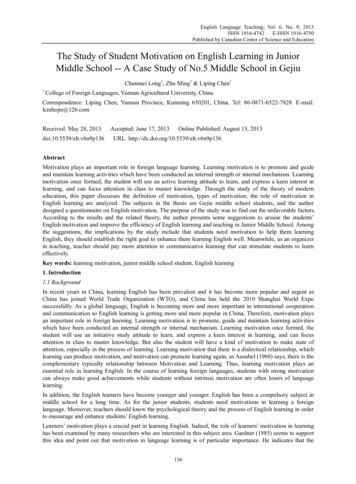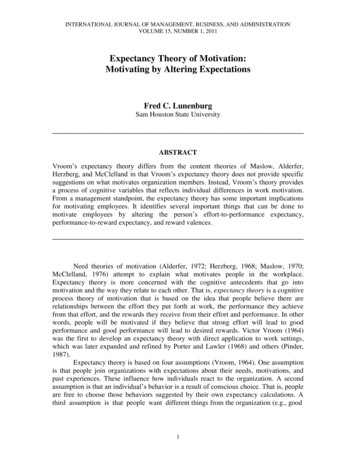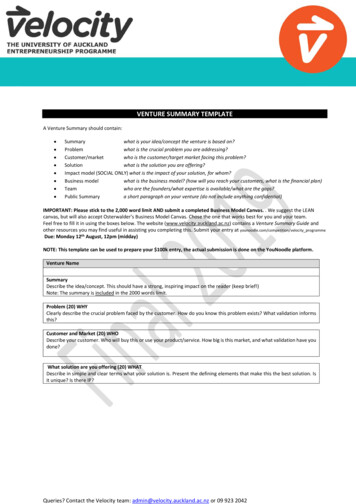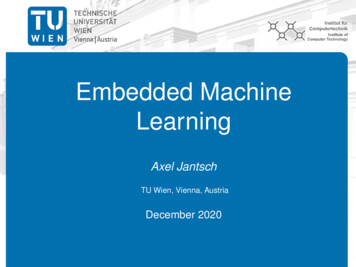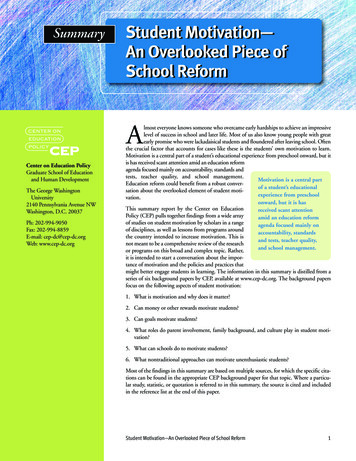
Transcription
SummaryStudent Motivation—An Overlooked Piece ofSchool ReformACenter on Education PolicyGraduate School of Educationand Human DevelopmentThe George WashingtonUniversity2140 Pennsylvania Avenue NWWashington, D.C. 20037Ph: 202-994-9050Fax: 202-994-8859E-mail: cep-dc@cep-dc.orgWeb: www.cep-dc.orglmost everyone knows someone who overcame early hardships to achieve an impressivelevel of success in school and later life. Most of us also know young people with greatearly promise who were lackadaisical students and floundered after leaving school. Oftenthe crucial factor that accounts for cases like these is the students’ own motivation to learn.Motivation is a central part of a student’s educational experience from preschool onward, but itis has received scant attention amid an education reformagenda focused mainly on accountability, standards andtests, teacher quality, and school management.Motivation is a central partEducation reform could benefit from a robust converof a student’s educationalsation about the overlooked element of student motiexperience from preschoolvation.onward, but it is hasThis summary report by the Center on Educationreceived scant attentionPolicy (CEP) pulls together findings from a wide arrayamid an education reformof studies on student motivation by scholars in a rangeagenda focused mainly onof disciplines, as well as lessons from programs aroundaccountability, standardsthe country intended to increase motivation. This isand tests, teacher quality,not meant to be a comprehensive review of the researchand school management.or programs on this broad and complex topic. Rather,it is intended to start a conversation about the importance of motivation and the policies and practices thatmight better engage students in learning. The information in this summary is distilled from aseries of six background papers by CEP, available at www.cep-dc.org. The background papersfocus on the following aspects of student motivation:1. What is motivation and why does it matter?2. Can money or other rewards motivate students?3. Can goals motivate students?4. What roles do parent involvement, family background, and culture play in student motivation?5. What can schools do to motivate students?6. What nontraditional approaches can motivate unenthusiastic students?Most of the findings in this summary are based on multiple sources, for which the specific citations can be found in the appropriate CEP background paper for that topic. Where a particular study, statistic, or quotation is referred to in this summary, the source is cited and includedin the reference list at the end of this paper.Student Motivation—An Overlooked Piece of School Reform1
What Is Motivation and Why Does It Matter?Motivation can affect how students approach school in general,how they relate to teachers, howmuch time and effort they devoteto their studies, how much support they seek when they’re struggling, how they perform on tests,and many other aspects of education. If students aren’t motivated,it is difficult, if not impossible, toimprove their academic achievement, no matter how good the teacher, curriculum or school is.Moreover, unmotivated students can disengage other students fromacademics, which can affect the environment of an entire classroomor school.If students aren’tmotivated, it is difficult,if not impossible, toimprove their academicachievement, no matterhow good the teacher,curriculum or school is.Higher motivation to learn hasHigher motivation to learnbeen linked not only to betteracademic performance, but tohas been linked not only togreater conceptual understandbetter academicing, satisfaction with school,performance, but to greaterself-esteem, social adjustment,conceptual understanding,and school completion rates.satisfaction with school, selfMotivation often declines asesteem, social adjustment,students progress from eleand school completion rates.mentary through high school.Upwards of 40% of highschool students are disengagedfrom learning, are inattentive, exert little effort on school work, andreport being bored in school, according to a 2004 analysis by theNational Research Council. The lack of motivation has serious consequences. For example, in a 2006 survey exploring why studentsdropped out of school, 70% of high school dropouts said they wereunmotivated (Bridgeland, DiIulio & Morison, 2006).Motivation is difficult to define and measure, but scholars generallyrecognize two major types of motivation: intrinsic and extrinsic.Intrinsic motivation is the desire to do or achieve something becauseone truly wants to and takes pleasure or sees value in doing so.Extrinsic motivation is the desire to do or achieve something not somuch for the enjoyment of the activity itself, but because it will produce a certain result. The difference between the two is more like aspectrum than a divide; any action can be motivated by a combination of intrinsic and extrinsic factors, and the same person may bemotivated differently in different contexts.Students’ beliefs can affect their motivation. For example, studentswho believe they have a limited capacity to learn or feel they areunlikely to succeed often have problems with motivation. In a similar vein, students who conceptualize intelligence as a fixed quantitythat one either has or doesn’t have tend to be less motivated than students who view knowledge as something that can change and grow.Researchers generally agree on four major dimensions that contributeto student motivation, shown in the box below. At least one of thesedimensions must be satisfied for a student to be motivated. The moreStudent Motivation—An Overlooked Piece of School Reformdimensions that are met, and the more strongly they are met, thegreater the motivation will be.Four Dimensions of Motivation Competence — The student believes he or she has the ability tocomplete the task. Control/autonomy — The student feels in control by seeing adirect link between his or her actions and an outcome and retainsautonomy by having some choice about whether or how toundertake the task. Interest/value — The student has some interest in the task orsees the value of completing it. Relatedness — Completing the task brings the student socialrewards, such as a sense of belonging to a classroom or otherdesired social group or approval from a person of social importanceto the student.Sources: Bandura, 1996; Dweck, 2010; Murray, 2011; Pintrich, 2003; Ryan &Deci, 2000; Seifert, 2004The interplay of these dimensions—along with other dynamics suchas school climate and home environment—is quite complex andvaries not only among different students but also within the samestudent in different situations. Still, this basic framework can be helpful in designing or analyzing the impact of various strategies toincrease students’ motivation.Can Money or Other Rewards MotivateStudents?Some schools and districts have sought to motivate students to workharder by providing them with money or other rewards. Examplesinclude programs that give cash to students for earning good grades,reading books, attendingafter-school study sessions,demonstrating good attenProponents of using rewardsdance and behavior, orto motivate students contendattaining a passing score orthat these programs can helphigher score on an importantbring balance to anexam. Examples of non-casheducational system thatrewards include giving cellexpects students to exertphones and phone minuteseffort up front for theto students for good behavpromise of rewards that areior, test scores, attendance,or homework completion;delayed or difficult to grasp.giving pizza coupons to students who make goodgrades; or awarding studentswho make the honor roll with certificates they can use for specialprivileges like an early release from school. This concept of providingrewards as motivation is controversial, and the results of these programs are mixed, or in some cases unevaluated.Center on Education Policy 2
Proponents of using rewards to motivate students contend that theseprograms can help bring balance to an educational system that expectsstudents to exert effort up front for the promise of rewards that aredelayed or difficult to grasp. Moreover, some proponents note,rewards have long been a part of education (think gold stars) and canhelp level the playing field for low-income students whose parentslack the means to offer them incentives for academic success. Someadvocates argue that pursuing a reward can change students’ behaviors in positive ways for the duration of the reward program and perhaps after the reward ends. Others point out that rewards may be theonly way to motivate students to apply themselves to tasks that haveno value to them, such as taking standardized tests that have no consequences for students but are important for their school.Many opponents, for their part,contend that rewarding studentsfor desirable behavior runscounter to the true goal of education, which should be todevelop students’ curiosity andintrinsic love of learning. Someargue that when the reward program ends, students no longerhave a reason to continue theirbehavior. Rewarding performance is unfair, some opponentssay, because students who arenaturally talented will easily earnrewards, while less talented students may try hard but still not qualify for a reward. Some opponents also point to evidence suggestingthat extrinsic rewards can encourage a compliance mentality anddecrease intrinsic motivation.Rewarding specific actionsthat students can control,such as completinghomework, yields betterresults than rewardingaccomplishments thatmay seem beyond theirreach or out of theircontrol, such as whetherthey earn an A grade.But do reward programs work? Answering this question is complicated by the fact that many such programs have been carried out injust one district, school, or classroom, and even similar programs canbe implemented differently in different settings. In addition, it’simportant to analyze not only what happens to student motivationwhile the program is in place, but also what happens after the rewardsare removed.In general, studies of reward programs have shown mixed results. Forexample, a comprehensive study by Harvard economist Ronald Fryer(2011) of differently structured reward programs in four cities foundvery different outcomes, depending on which behaviors were rewardedand how the programs were designed. Paying students to increase theirtest scores produced no improvements in test scores or grades, in partbecause students had little knowledge of how to control their testscores. Paying students for reading books and taking a correspondingquiz produced the best results—a dramatic rise in standardized testscores which continued at about half the rate of gain in the year afterthe program ended. This latter program targeted the youngest students and paid them for something entirely within their control.Another study (Raymond, 2008) looked at a diverse group of rewardprograms in 186 charter schools; the specific rewards and programdesigns varied, but most of the programs rewarded a combination ofacademic outcomes and behaviors. The only stable and consistent positive effect across programs was an increase in reading achievement.Student Motivation—An Overlooked Piece of School ReformThe most successful reward systems, this study concluded, used nearcontinuous assessments of behavior, applied rules consistently, hadstrong alignment among school personnel, and rewarded behaviorsthat were under students’ control.Other studies have also found test score gains in reading for studentsparticipating in reward programs. Some reward programs have alsoyielded improvements for some participants in scores on collegeentrance exams or other standardized tests, although these gains weremostly small, and there is little evidence that they were sustained inthe long-term. Few studies have followed the effects on students foryears after a reward program ends.On the whole, research shows that reward programs can have positiveeffects if they are implemented thoughtfully, carefully, and within aset of guidelines, and if they address the four dimensions of motivation mentioned above. For example, rewarding students for masteryof a discrete task, skill, or subject, such as reading a book or solvinga problem, works better than rewarding them for performance, suchas reaching a certain benchmark on a test. Rewarding specific actionsthat students can control, such as completing homework, yields better results than rewarding accomplishments that may seem beyondtheir reach or out of their control, such as whether they earn an Agrade. Rewards that are too large can be counterproductive becausestudents may feel pressured into taking part.At the same time, poorly designed reward programs can actuallydecrease motivation if they are targeted at the wrong students, do notbuild on the four dimensions of motivation, or are implemented ineffectively. Mark Lepper and colleagues found that students who wererewarded for drawing drew more often, but when the reward wasremoved, they drew less often than they originally had and were lesslikely to do so purely for pleasure later (Lepper, 1973). Other studies have similarly found that rewarding students for activities theyinherently enjoy can decrease motivation. Finally, students who weregiven a financial reward for solving a series of problems had a moredifficult time when they had to solve problems that required a different strategy, suggesting the reward had undermined their “cognitive flexibility” (Rigby et al., 1992).Can Goals Motivate Students?Students who are not motivated by love of learning alone may dobetter in school if they can see learning as a gateway to somethingelse they value. Research suggests that goals can help motivate students to work harder if certain conditions are present.The goal should be realistic,Mastery-based goals, whichachievable, and educationinvolve demonstratingdependent. The goal shouldincreased understanding,be suggested, or at leastskills, and contentembraced, by the student,knowledge, are preferable toand the student must be ableperformance-based goals,to see a clear path for attainwhich involve reaching a preing the goal. It also helps ifdefined level of performancethe goal is supported by peoor outperforming others.ple important to the student.Center on Education Policy 3
Mastery-based goals, which involve demonstrating increased understanding, skills, and content knowledge, are preferable to performance-based goals, which involve reaching a pre-defined level ofperformance or outperforming others. Goals can actually underminemotivation, however, if they are too difficult, or if students feel thata goal has been imposed on them or that failing to meet it wouldhave dire consequences.Two common goals in education—passing assessments and gettinginto college—provide a useful lens for examining motivation.While programs that simplyencourage students to attendcollege have had somelimited success, the mostpositive results have beenfound in programs thathelped students understandwhat they needed to do toget into college andprovided them withcounseling, academicsupport, and other servicesto enable them to succeed ateach step along the way.Most assessments appeal tostudents’ extrinsic rather thanintrinsic motivation. Someassessments provide directextrinsic goals for students,such as passing a course orgaining admission to a competitive college. Other assessments, particularly those usedfor school accountability, provide extrinsic goals for teachers and administrators, whomay pass along the pressure ofthese goals to students. Thereare high-stakes and low-stakesassessments, as well as classroom and external assessments, that together comprisea continuum of motivation.Assessments with high stakes for students—from a classroom test thatcounts for a major portion of a course grade to an external state exitexam that students must pass to graduate from high school—are generally considered more motivating than those with low stakes or nostakes, but this is not always clear-cut. While high-stakes assessmentsdo spur some students to work harder, they can have a negative effecton the motivation of other students by evoking anxiety, frustration,or fear of failure. And while some instructional practices used to prepare students for high-stakes external assessments, such as providingextra help for low-achieving students, would generally be consideredpositive, other types could decrease students’ interest and motivation.Examples of the latter type include the elimination of interesting andvaluable content to make more time to teach material likely to betested or an excessive emphasis on drill-and-practice instruction.As currently implemented, most high-stakes assessments encourage aperformance-based mindset rather than the more motivating mastery-based mindset. Of course, assessments serve other useful purposes, such as providing information about how well students arelearning and which students need help. But if assessments are to beused as a motivational tool, it’s important to consider which types ofassessments can provide useful information about students’ learningand are aligned most closely with the key dimensions of motivationdiscussed above. Motivational theory suggests that assessments thatreward growth and effort encourage a mastery-based mindset andtherefore have a stronger motivational effect. More frequent assessments that start with easier goals and gradually increase in difficultycan build students’ competence and sense of control, as can opporStudent Motivation—An Overlooked Piece of School Reformtunities for students to demonstrate their knowledge with performance tasks or low-stakes tests before taking an assessment that counts.Several programs have sought to improve the motivation of elementary and secondary students by encouraging them to aspire to college. For example, some philanthropists have promised to pay forcollege for any student in a particular class who meets admission criteria. Other programs have taken a more comprehensive approachby providing at-risk students with a range of supports to create a “college-bound climate” in elementary and secondary schools. These supports vary but may include specialized college counseling, tutoringand encouragement to complete the necessary coursework, visits tocollege campuses, assistance with applications, and funds to covercollege entrance exams.Studies of these programs indicate that postsecondary education canbe a motivating goal if students receive supports that address the fourdimensions of motivation mentioned earlier. While programs thatsimply encourage students to attend college have had some limitedsuccess, the most positive results have been found in programs thathelped students understand what they needed to do to get into college and provided them with counseling, academic support, and otherservices to enable them to succeed at each step along the way. The goalof postsecondary education is also more motivating if students can seefor themselves the value of attending college and if their peers andrespected adults support this goal.What Roles Do Parents, Family Background,and Culture Play in Student Motivation?Many studies have documented the strong relationship between family background factors, such as income and parents’ educational levels, and student achievement, and the positive impact of parentinvolvement on achievement. A much smaller body of research looksspecifically at how variousfamily background and cultural factors, as well parents’Reading to children, talkingattitudes and actions, canwith children about whataffect children’s motivation tothey read, interacting withlearn and succeed in school.children about academics,and celebrating moments ofParents who are activelyintellectual discovery areinvolved in their children’seducation and provide a stimamong the activities thatulating learning environmentpromote achievement andat home can help their chilmotivation.dren develop feelings of competence, control, curiosity,and positive attitudes aboutacademics, according to various studies. Reading to children, talkingwith children about what they read, interacting with children aboutacademics, and celebrating moments of intellectual discovery areamong the activities that promote achievement and motivation.Parents’ beliefs and expectations also appear to strongly influence children’s motivation. For example, parents who hold high expectationsfor their children’s learning, believe in their children’s competence,expose them to new experiences, and encourage curiosity, persistence,Center on Education Policy 4
and problem-solving can helpSome parental actions, suchtheir children develop anintrinsic motivation to learn.as praising children’sBy contrast, parents who areintelligence rather than theircontrolling, use rewards andmastery of knowledge andpunishments for academicskills, can send a messageperformance, or display negathat intelligence is a fixedtivity or anger about academattribute—a belief that canics can discourage childrenlead children to avoidfrom developing intrinsicchallenges or fear failure.motivation. Some parentalactions, such as praising children’s intelligence rather thantheir mastery of knowledge and skills, can send a message that intelligence is a fixed attribute—a belief that can lead children to avoid challenges or fear failure.Creating a home environment that nurtures motivation involveseffort for any parent, but it can be especially problematic for socioeconomically disadvantaged families—those with limited financialresources, low educational levels, single-parent homes, and otherstresses. Much attention has been devoted to achievement gapsbetween students from low-income and higher-income families, andbetween students of different racial/ethnic backgrounds. Similar gapshave also been found between disadvantaged and advantaged children in non-cognitive or “soft” skills that are critical to success inschool and later life—including motivation, self-regulation, and selfesteem, as well as the abilities to work with others, focus on tasks,and defer gratification (Heckman, 2011). Like achievement gaps,these soft skill gaps emerge before children start school and persist asthey progress through school. For example, one study found that students from families with high socioeconomic status (SES) tended toapproach academic challenges with a greater sense of internal controlover success than students from low-SES families (Young et al., 2011).Although the causes of gaps in achievement or soft skills are not fullyunderstood, some studies have suggested that differences in parentingpractices and social context are contributing factors. Children borninto socioeconomically disadvantaged circumstances, particularly single-parent homes, are less likely to have the opportunity to benefitfrom the kinds of parental attention, activities, and resources that stimulate these skills (McLanahan, 2004). As summarized by Heckman,disadvantaged mothers, as a group, “talk to their children less and areless likely to read to them daily . . . [and] tend to encourage their children less, adopt harsher parenting styles, and be less engaged with theirchildren’s school work” (Heckman, 2011, p. 80). In other words, children from disadvantaged families tend to have fewer opportunities athome that foster competence, encourage them to find interest or seevalue in learning, promote autonomous learning, or develop socialrelationships that support and value achievement.Differences in parenting practices among low-SES or racial/ethnicgroups are partly explained by disparities in social and material resources,such as disparities in income and accumulated wealth, parents’ level ofschooling and academic skills, and access to social networks and institutions that control information or can provide assistance.These research findings do not mean that children from disadvantaged families are doomed to skill gaps and low academic motivation.Student Motivation—An Overlooked Piece of School ReformA variety of programs have been put in place to help low-SES andminority parents create supportive home environments, share successful strategies, and encourage their children to see academicachievement as a meaningful and realistic part of their group identity.According to Ferguson (2007), some parenting intervention programs have produced moderately large achievement gains even in rigorous trials. But actions to address children’s beliefs about learningand foster supportive parenting must begin early and cannot beaccomplished by schools alone. The solution, some experts suggest,is not to blame parents for gaps in skill development but instead toprovide disadvantaged families with the broad range of resources necessary to prevent these gaps from forming in the first place.Another line of research hasexplored racial, ethnic, and cultural differences in students’ attitudes that may influencechildren’s motivation to succeedin school. Findings from thesestudies are often hotly debated,and recent analyses that look atcurrent conceptions of motivation through the lens of race, ethnicity, or culture are limited.Actions to addresschildren’s beliefs aboutlearning and fostersupportive parentingmust begin early andcannot be accomplishedby schools alone.Some scholars, for example, have suggested that “stereotype threat,”or a fear that poor performance on tasks may confirm negative racialstereotypes, can undermine the competence of African American students—or any other group faced with a task that can invoke a damaging stereotype (Steele & Aronson, 1995; Aronson & Steele, 2005).They note that stereotype threat can dampen students’ competenceby heightening their anxiety, depleting their self-regulation skills, orspurring them to avoid challenges.Other researchers have conjectured that a desire to maintain a distinctcultural identity in opposition to the dominant group can negativelyaffect academic motivation—most notably, when high-achievingAfrican American students are accused by their peers of “acting white”(Fordham & Ogbu, 1986; Fryer & Torelli, 2010). But this conclusion has been challenged by researchers who cite evidence that bothAfrican American and white students want to succeed in school andthat high-achieving students share similar experiences and challenges,regardless of their race (Tyson, Darity, & Castellino, 2005).Several studies have explored how social and cultural context can havea bearing on students’ motivations or aspirations. For example, someresearchers assert that experiences with or perceptions of discrimination can damage the confidence of students of color and contributeto academic disengagement (Graham & Hudley, 2005). Othersmaintain that social context can lead some children to perceive thatcertain type of behaviors, such as spending time on homework, arepointless and “not for people like me” (Oyserman & Destin, 2010,p. 1002).Findings with relevance to both the parenting and cultural aspects ofmotivation come from research that explores why Asian Americanstudents as a group have high academic achievement. Studies havefound that, in general, Asian American students tend to attribute academic outcomes to effort more than innate ability, a belief that isassociated with intrinsic motivation. Research has also found thatCenter on Education Policy 5
Asian American parents, on average, have higher academic expectations of their children than do parents of other groups, and thatparental pressure and a desire to meet high parental expectationsappear to be primary catalysts of motivation among Asian Americanstudents (Eaton & Dembo, 1997). At the same time, stereotypes thatall Asian Americans are high achievers can negatively affect the motivation of some Asian American students by making them anxiousabout living up to this perception (Graham & Hudley, 2005).What Can Schools Do to Better MotivateStudents?Schools play an important role in boosting student motivation bypicking up where parents leave off or stepping in when parents areunable or reluctant to be actively involved. Various elements ofschooling, from teachers’ interactions with students to school organization, can have an impact on student motivation.School-based efforts to improve student motivation generally fall intoone of three categories: targeted intervention programs for studentsat risk, programs focused on teachers as motivators, and efforts toreorganize schools.Targeted intervention programs identify students whoSchools play an importantare at risk of dropping out orrole in boosting studentwho show other indicators ofmotivation by picking uplagging motivation, such aswhere parents leave off orpoor attendance or a failure tostepping in when parentscomplete assignments. Theare unable or reluctant togoal is to rekindle students’be actively involved.interest in school before theydisengage for good. Examplesof the many types of targetedinterventions used by districts and schools include the following: An Ohio program for boys at risk of dropping out provided personal motivators, participation in special extracurricular activities, and close monitoring of students’ progress by aschool-community team. After the first year of the program, participants’ grade promotion and attendance rates increased andsuspension rates decreased (Hoke, 2008; Stephens, 2008). A program in the Baltimore City Public Schools identified whychronically absent students were missing school and respondedwith individualized interventions, such as mentors, home visits,meetings with parents, and involvement of service providers ifnecessary. The percentage of chronically absent students declined,dropout rates decreased, and the graduation rate increased(Sundius & Fothergill, 2010). Districts in several states have instituted Performance LearningCenters, a model developed by the Communities
early promise who were lackadaisical students and floundered after leaving school. Often the crucial factor that accounts for cases like these is the students’ own motivation to learn. Motivation is a central part of a student’s educational experience from preschool onward, but it is has received scant attention amid an education reformFile Size: 519KB
